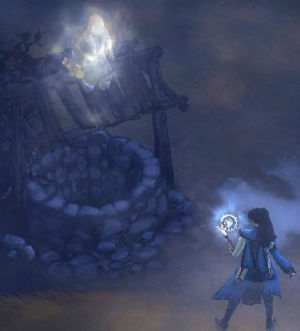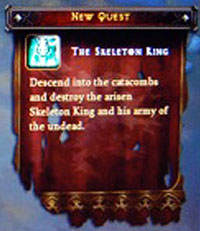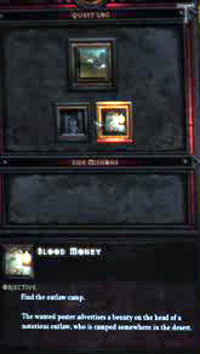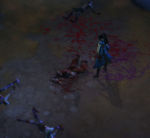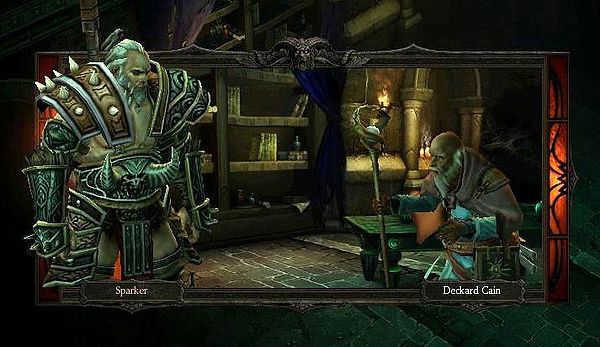Quest
Quest is a game term for most RPGs to describe how a character progresses through the story or accomplishes tasks. Quests are missions with varying levels of complicated objectives, normally giving the player experience, gold, items or other rewards when completed.
Quests in Diablo III will be made more in line with the story, and less obtrusive than traditional action RPGs.
Contents
Diablo III Quests
The D3 Team wants to improve on how quests were handled in Diablo II. They want the major quests to be interesting, important, and plot-driven. Many of these quests will be character-specific; your character won't (always) just be an errand boy and the quest won't just be something minor; it will advance the story.
Each act has numerous major, plot-related quests, all of which have various related minor quests related to them. Blizzard has released very little information about the game's plot, so the only quests known thus far were the ones seen in the playable demos at Blizzcon 2008 and 2009.
In addition to the official quests, there are numerous smaller "Adventures" which play like mini-quests. See the section further down this page for more details on them.
Known Quests
All known quests were researched in the Blizzcon 2008 and 2009 playable demos. Details of these quests may change in the final game.
Click the quest names below to read full articles on each quest with many more details and screenshots.
Blizzcon 2008 Quests
All these quests were located in Tristram or the dungeons below the ruined town. The base camp at Tristram was quite small and inhabited by only two NPCs, neither of whom were merchants. It's expected that the full town of Tristram will be quite a bit larger. (Or this base camp might be where new characters begin the game, and they only reach the full Tristram after completing these introductory quests.)
Blizzcon 2009 Quests
All of these quests were located in the deserts of Act 2, somewhere in the mid-section of the act. Characters started out just beyond the walls of Caldeum, and could not return to the city. The designers revealed that this was a special fix just for the demo, since players would have seen a great deal of the game story in Caldeum, and the didn't want to reveal that much of it yet.
- Find Alcarnus
- Blood Money
- Stranded
- The Lost Girl
- Alesar’s Pendant
- The Collapsing Tomb
- The Lost Wagon
- The Necromancer's Book
- A Miner's Gold
- The Idol of Rygnar
Quest names are tentative, and may change in the final game.
Quest Design and Theory
Leonard Boyarsky is the main story guy on the D3 Team and while he isn't the only person who makes up quests, he heads up that department in the development of Diablo 3. Leonard was asked how quests are designed in an October 2009 interview. [1]
- Hellforge: How do you come up with ideas for the creation of quests in Diablo III. Do you start with simple quest concepts and build around them with storyline elements or...?
- Leonard Boyarsky: It goes both ways. What we do, the way we start off, is that we first create the storyline of the game and then we kind of iterate on that a lot as well as once we start building the game and putting quests in we refine those. Our artists, our level designers, everybody might have ideas about quests that would be more like simple adventure concepts or simple quest concepts that you’re talking about. And then we’ll put lore into them. Sometimes, we just have lore and we say to the level guys or some the gameplay guys, “Hey, how best do you think we can show this?” So it really goes both ways, any which way.
- There’s been times when we really wanted to hit certain points and it wasn’t really working because you know, it was too complex for the way the game is working or the way the story is rolling out so you know it’s really just an iterative process like the other stuff we do.
Randomization?
While the main quests in each act will not be random, most of the smaller quests will be. Diablo 3 quests will not be totally random; there is writing and design involved in creating them; but most areas of the game will have more quests than can occur each game. There may be 6 quests that can possibly appear in one section, of which 3 or 4 will appear each game. In this way players will see different combinations of events each time they play through the game.
There may also be rarer quests, ones that appear very seldom, giving a special surprise to players who luck into them. Leonard Boyarsky elaborated on how random quests will be integrated in an October 2009 interview. [2]
- We’re doing -– there’s a main storyline that is, parts of it might be randomized depending on the area, depending on what the quests are, depending on what the actual objective is. But apart from the main quest, most of our other content is randomized, so from game to game it will be completely different. I can’t give you any kind of percentage because we’re still playing with those numbers, but that’s really the way we built this game is so that we can have a lot of randomized content, including story elements and including quests.
High Level Quests
The Diablo 3 team has brought up quests as one way to solve the end game problems, where characters wind up just "running" the same bosses over and over again. The team hopes to allow/require more variety in gameplay by offering a variety of quests in the late game, giving players more viable activities to engage in. Julian Love addressed this question in an October 2009 interview. [3]
- DS: I think Jay hinted during Blizzcon that there might be updated quests to keep higher level content exciting to keep people coming back and playing again.
- Julian Love: It's not so much actually high level versus low level. I think we have a plan that facilitates high level content. What I think you're really getting at there is replayability, and what that gets down to is the way we're exercising randomness within the game. We've put a lot of focus towards what kinds of randomness are really beneficial in supporting replayability and what things are just, heh, not all that important or not all that awesome. One of the things that we have in the system that we have is something that we call - well, we have a really technical name for it -- sub-scenes.
- What it comes down to is we can sort of like create a hole in the world that's like a socket that we can fill with just about anything that we want. It could be empty ground with a bunch of monsters on it, it could be a giant canyon that a really elaborate scripted event happens, it could turn into a caravan walking across the desert that you have an escort quest on. The point being is that this hole in the earth can randomly, at any time become something totally different. It could even be a doorway to a whole new dungeon that you've never seen before. So, the fact that the world is able to change things up and actually deliver different events, stories and quests is what's really going to make the game a lot more replayable at the both the low and high ends.
Quest Interface
The quest interface remains under development, as evidenced by how much it changed between Blizzcon 2008 and 2009. The 2008 version was more ornate and stylized, and filled up much more of the visible screen. In 2009 the interface was far simpler, and looked like a scaled back version of Diablo 2's quest window. It's expected that the final game version will be fancier than the no-frills 2009 version, and it's possible that the very plain 2009 version was something put together just for the Blizzcon demo, since it didn't seem able to expand to hold more than just the few quests available in that demo build.
In the 2009 build, the main quest was to find Alcarnus, and that quest always showed on top of the pyramid of potential quests. Below the Alcarnus quest were two two other quests, which were different each game. There seemed to be 4 or 5 possible quests for those two slots. Below those two were four other quests, which were related to/contained within them. This third row of quests were generally the most simple, "Fed-Ex" style of quests. Players had to five stranded NPC soldiers and fight off the Lacuni that were attacking them, or locate an abandoned wagon and retrieve the treasure. These were simple, but at least there were none of the dreaded, "Go fetch me 8 skins of the desert monster" type quests that RPGs such as WoW have made so infamous.
When a character performed an action that changed the state of a quest, such as receiving a clue from an NPC, finding a quest item, or finishing a quest entirely, a little ! icon popped up over the belt interface. That let the plaeyr know to open the quest window, where new info about the quest would display. That image is seen below.
(All of these images were taken from cell phone camera recordings of the game screens, mostly from the 2009 PAX convention, hence their low quality.)
New Tools
There are a variety of improvements to the quest aspect of the User Interface in Diablo 3. Besides the basic quest window, there's an audio player-style interface that pops up on the side of the screen when a character has an NPC speech to listen to. This gives players the ability to listen to longer NPC dialogues, or to "read" ancient tomes and other objects that relate the game story without having to stand still for the duration of the audio.
Leonard Boyarsky elaborated on this in an October 2009 interview. [4]
- The lore book that we’ve been putting in has been really popular. People like the ability to hear background stuff while they run around killing things as opposed to having to stop to read. So, we’re pretty surprised by that because people generally split into two different kinds of classes: the people who care about the lore and the people who could care less, but we’re finding that with the lore books that people have really responded to them. I’m assuming that’s because the audio portion of it where they don’t have to stop and sit and read it doesn’t cut into the action, basically.
Like, we put in some background of Leoric, his journal and Lachdanan who are characters that you’ve heard about and didn’t really meet in their human forms in the first Diablo, so you get to hear their voices and their stories from their point of view. It’s just that I think people are really kind of interested in that especially if they’ve played the games all the way from the first one.
Quests as Story
The D3 Team is trying to make Diablo III much more story-driven. They want the characters to be individuals and to be important figures in the world; not just interchangeable errand boys, as they usually were in Diablo II. Leonard Boyarsky talked about this in an interview in September, 2008.[5]
- The areas of story and character development will now be in focus, and the team wants the players to feel like they are having an effect on the world, which can also affect the character. They don't want the game to be either action or RPG, the two can mix. The story elements just need to be more engaging "without interfering with the hack-and-slash gameplay". It's possible for players to opt out if they don't care about it, "but if you do care about it, the story will bring a whole extra level of involvement to the game experience," Boyarsky said. As few as possible quests will be mandatory, and instead having a lots of voluntary quests and random quests if you want to.
The team is also "doing a lot with scripted sequences and books that you can read in the game, but once again, you can completely avoid these things if they don't interest you."
Specifics about quests related to the lore/story of the game have not yet been revealed but it was discussed in the WWI 2008 Lore and Environmental Art Panel, when a fan asked if there would be quests to obtain special items, such as the Horadric Cube. The team at the panel said they "look into the story and lore and we want that to drive the gameplay and quests."
Scripted Events

Jay Wilson talked about some of the scripted events seen in the BlizzCon demo in an interview in December, 2008.[6]
- We had a lot of [scripted events] in our BlizzCon build. [In one of them, there was] a series of ghosts at an altar who were seeking an object that you'd get to prove your worth. If you did get it, then they would test you by having big powerful monsters attack you -- and if you passed, you got a nice reward. Another one was coming across some fellow adventurers stranded in a dungeon who'd need your help to get out.
Several of these scripted events will be used in Diablo III. Both as the mandatory quests as well as the optional, random and encounter/adventure type quests.
There were even more potential events, quests, and adventures in the 2009 demo build, as Julian Love revealed in an interview from the show. [7]
- I think in the demo that we have here, there’s just over 30 different things that can happen in all the spots. Whether that’s too high or too low will be partly based on what feedback we’re going to see from the people that actually got a chance to play it here, and based on what we feel like. We know how we feel about it right now but we want to compare that to what the players who have a chance to play feel, and then we’re going to try to look at that again. So this is one big area, what a smaller area or one that’s more linear has is also yet to be determined. But certainly way more things will happen in one playing area than happened in Diablo II.
Adventures
Adventures are mini-quests, scripted events or semi-random occurrences that aren't necessarily tied to the overall plot. Adventures tend to be small and self-contained, but they're well worth completing, since they are fun, and often pack valuable rewards. The D3 Team first described them in the WWI 2008 Design Fundamentals Panel.
- Jay Wilson: Yyou could come across a particular area in the outdoor world with a variety of possible elements in it. One game it could be a old abandoned house to explore. Maybe it's infested with crazy undead guys, and as you clean it out you learn the story of the family who lived there. Another game that same area might instead have a clearing where a cult is performing a summoning ritual. Another game might feature a caravan that needs protection from marauding monsters, or escort to the nearest town. Another game you might find a boss monster there. Or you might just get random monsters."
This concept was seen in action in the Act 2 desert at Blizzcon 2009, when some fans had a chance to play through the same area in multiple games. One time a desert region would be empty, the next it would have a ruined building with a horde of monsters inside of it, and another it would have a mini-quest to find a ruined wagon. The concept is to add randomization even within the randomized dungeons, and to change up the play style. [8]
- The biggest goal we have with these is that we want to change what the player is doing. Whenever you can basically take the core game and make the player play it in a slightly different way, it makes the game a lot more interesting and keeps it from being tedious. You go from "I'm killing monsters aimlessly" to "I'm now killing monsters to protect this thing." That's easily a more interesting scenario, because it's different than what you were doing, and that's our main goal with that.
Class-Specific Quests
During the game reveal in mid-2008, the D3 Team talked about class-specific quests at the Denizens of Diablo panel.
- We'll also have various class quests that will be very interesting. Each class will have different views of the story that will play out through conversations. Bottom line beyond all this is it gives us a way to put the hero at the center of the story. Your hero can drive the story as opposed to being errand boy. You can decide best thing to do. Villages can be cowardly, you can suggest we need to go do this, not just me. I can take control because no one else will. Puts you at centre of the action. Makes char have more of a hero feel.
This was taken to mean class-specific quests at the time, but in retrospect it seems like nothing more than some class-specific NPC dialogues. Those are known to be in the game; Captain Rumford showed them with his different remarks to the Barbarian, Wizard, and Witch Doctor at the start of the 2008 Blizzcon demo.
Like Rumford, all the important NPCs have different dialogues for and reactions to the different characters, and these are planned to be impactful; they're not just Gheed sounding worried when he first speaks to a Necromancer, before proceeding to treat that class exactly like anyone else.
How Many Quests?
The D3 Team has said that D3 will be about the same size as D2, but that it will have many more quests. This total presumably includes the smaller adventures, as well as main plot-driving quests. Jay Wilson commented on this in an August 2008 interview. [9]
- We believe Diablo 2 was a very good size, even with the number of quests. In any case, more than in Diablo 2, Diablo 3 will have more quests and many of them have a much stronger tie to the game. Compare this to Diablo 2, where quests generally came in 6 per Act, but in Diablo 3 we have no quest limit. So we can continue to insert as many quests as we like, until we feel that we've got a good amount and there aren't too many. We want to concentrate on quests that are really fun and contribute to the game. If I have to come up with a number, I'd say there's probably twice as many quests, but I wouldn't nail it down like that. It could still be more or less at this point.
More recently, Julian Love was asked about this at Blizzcon 2009. [10]
- GamePlanet: Will there be a maximum nubmer of quests?
- Julian Love: Probably, but it's undetermined at this point. I think in the demo that we have here, there's just over 30 different things that can happen in all the spots. Whether that's too high or too low will be partly based on what feedback we're going to see from the people that actually got a chance to play it here, and based on what we feel like. We know how we feel about it right now but we want to compare that to what the players who have a chance to play feel, and then we're going to try to look at that again. So this is one big area, what a smaller area or one that's more linear has is also yet to be determined. But certainly way more things will happen in one playing area than happened in Diablo II.
Quest Conversations
NPC conversations in Diablo III are shown in the normal game screen. The camera merely zooms in a bit. The conversation is ended and the screen returns to normal if you click anywhere outside of the dialogue tree, or press the space bar or Esc key.
When the game debuted at the WWI event in June 2008, NPC conversations were portrayed in a special pop up window display which you can see below. This approach was abandoned between the June premiere and BlizzCon in October, since the D3 Team felt that it took players out of the flow of the game.
